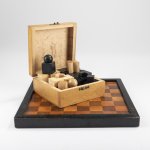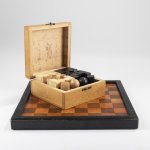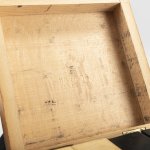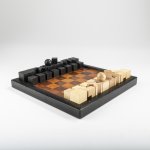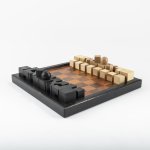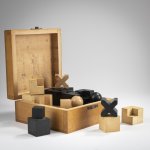Lot: 56
Josef Hartwig
Bauhaus - chess game 'XVI', 1924
32 figures. H. 2-4.5 cm. Made at Bauhaus, Weimar. Maple wood, partially stained dark
In the original wooden box (elmwood). H. 6 x 13.6 x 13.1 cm. Marked: HARTWIG GES.SCH. Included: game board for chess and checkers: 26.5 x 26.5 cm.
Hammer Price: 16,000 €
29. November 2022 at 3:00 PM CEST
Literature:
The chess set by Josef Hartwig is one of the most successful products designed at the Weimar Bauhaus. In 1922, the graduate of the Munich Academy, who worked from 1921 to 1925 as a foreman in the woodworking and sculpting workshops at the Weimar Bauhaus, began to design a chess game that differed fundamentally from traditional forms. Hartwig designed the game figures from simple stereometric bodies, from cubes, cylinders and spheres. Initially, the figures were made by hand, but the goal was industrial production. Hartwig himself explained the genesis of the forms in 1924: "Pawn and rook move at right angles to the edge of the board: expressed by the die. The knight moves perpendicularly in a hook shape on four squares: four dice combined perpendicularly. The bishop moves diagonally to the edge of the board: a diagonal cross cut out of the dice. The king moves perpendicularly and diagonally: a small cube across a corner on top of a larger one. The queen, the most mobile figure, consists of a cylinder and a sphere.” (The Bauhaus chess game by Josef Hartwig, p. 8). Bauhaus-Archiv Berlin, The Bauhaus chess game by Josef Hartwig, Berlin 2006, p. 19; Hahn, Experiment Bauhaus, Dessau 1988, p. 401; Bauhaus Archive, cat., Berlin 1987, pp. 149-50, cat. no. 288; exh. cat. Bauhaus 7, Galerie am Sachsenplatz, Leipzig 1991, ill. p. 43, cat. no. 134
Read our Terms & Conditions.







